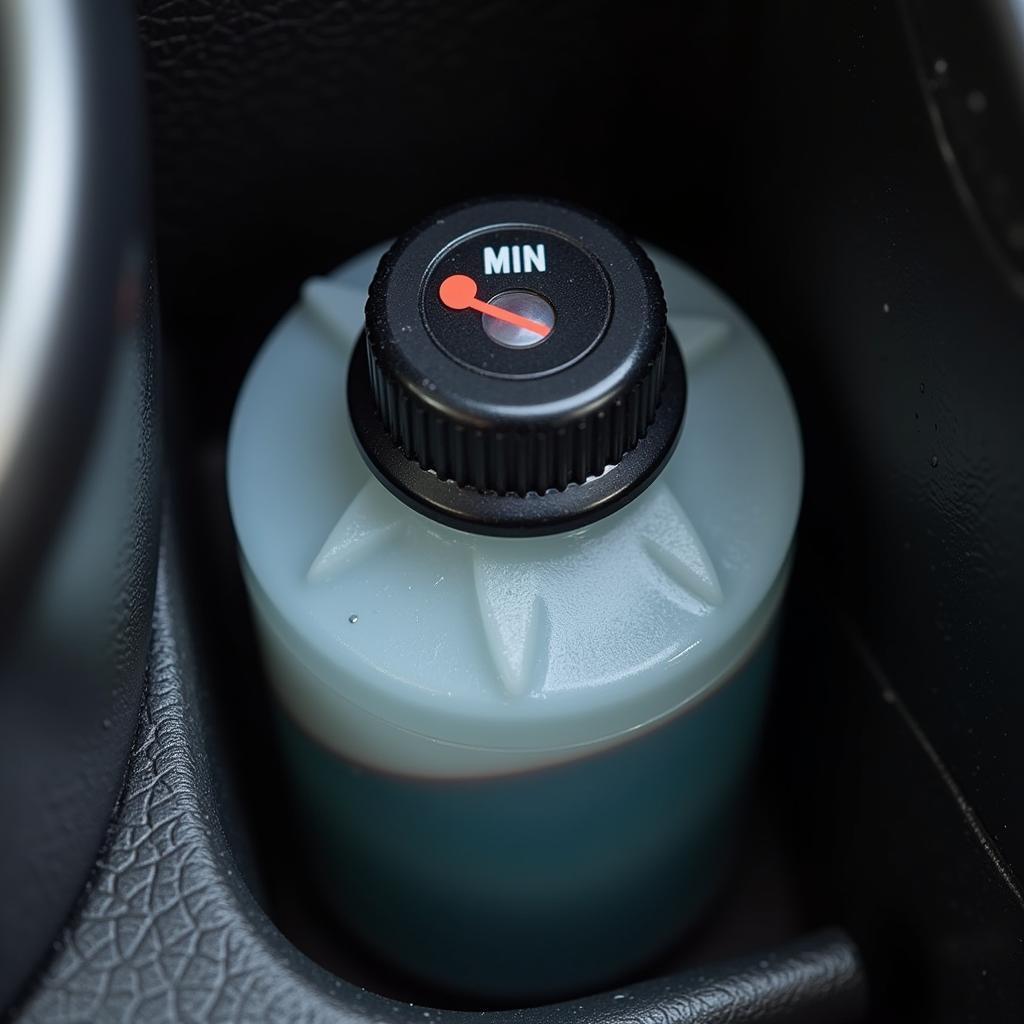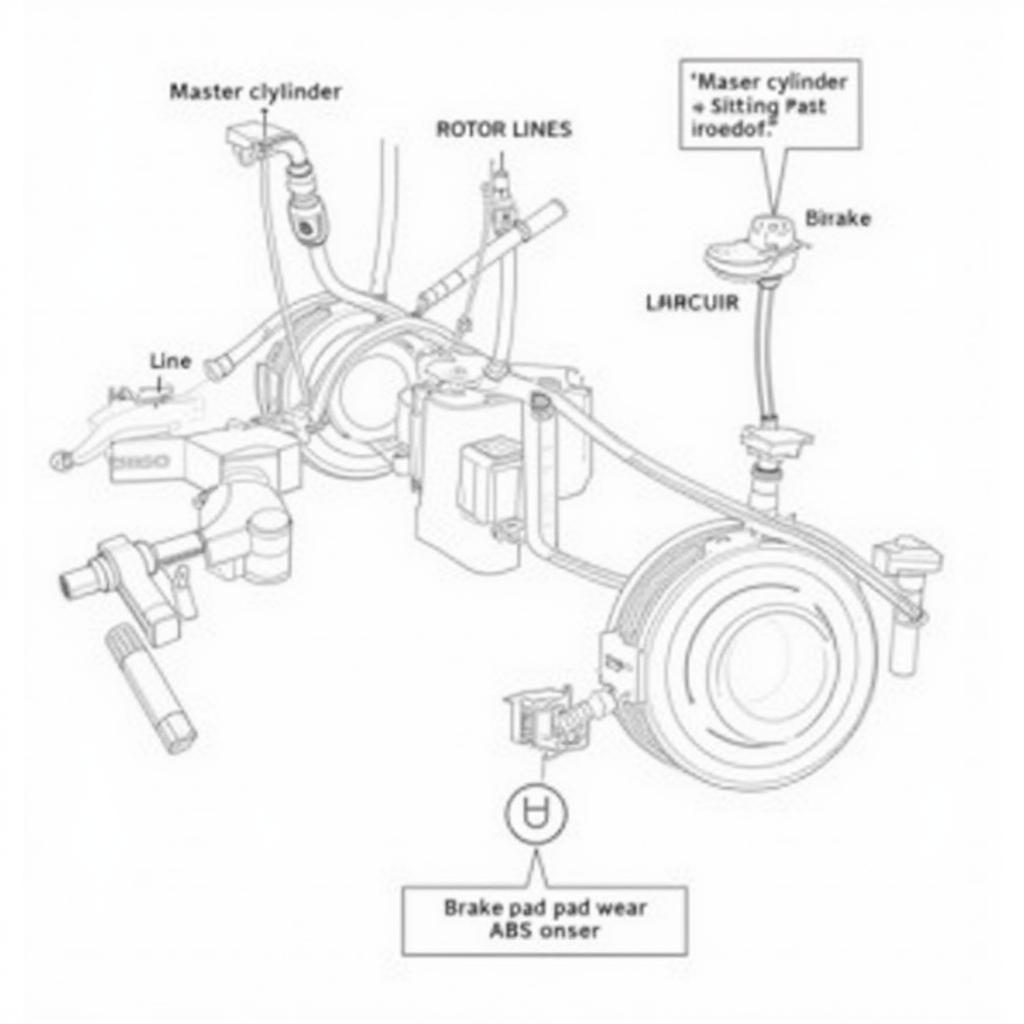The brake warning light on your Hyundai Tucson’s dashboard is a crucial safety feature, designed to alert you to potential issues within your braking system. Ignoring this warning light could lead to brake failure and dangerous driving conditions. This comprehensive guide will walk you through the common reasons your Hyundai Tucson’s brake warning light might be illuminated and provide you with potential solutions to get you back on the road safely.
Common Causes of a Hyundai Tucson Brake Warning Light
There are several reasons why your Hyundai Tucson’s brake warning light may be on. Some of the most common causes include:
- Low Brake Fluid: Brake fluid is essential for your Tucson’s braking system to function properly. If the fluid level is low, it could be due to worn brake pads, a leak in the system, or simply needing a top-up.
- Worn Brake Pads: Brake pads are designed to wear down over time. When they become too thin, the brake warning light will illuminate as a reminder to replace them.
- Faulty Brake Caliper: The brake caliper houses the brake pads and pistons. If a caliper becomes stuck or seizes, it can cause the brake warning light to come on.
- ABS Issue: Your Hyundai Tucson is equipped with an Anti-lock Braking System (ABS). If there is a fault within the ABS system, such as a malfunctioning wheel speed sensor, the brake warning light may turn on.
- Parking Brake Engaged: It might seem obvious, but a common reason for the brake warning light is an accidentally engaged parking brake.
Diagnosing the Problem
Identifying the specific cause of the brake warning light requires some investigation. Here’s what you can do:
- Check Your Parking Brake: Ensure your parking brake is fully disengaged.
- Inspect Your Brake Fluid Level: Locate the brake fluid reservoir under the hood. If the fluid level is below the “MIN” line, add the appropriate brake fluid.
- Examine Your Brake Pads: If you feel comfortable, you can visually check the thickness of your brake pads through the spaces between the wheel spokes. Thin brake pads require immediate replacement.
When to Seek Professional Help
While some causes of an illuminated brake warning light are straightforward to address, others require the expertise of a qualified mechanic. If you’ve checked the basics and the light remains on, or if you notice any of the following, seek professional assistance immediately:
- Soft or Spongy Brake Pedal: This indicates a potential issue with your brake hydraulics.
- Grinding Noise When Braking: This usually means your brake pads are completely worn down and require immediate replacement.
- Pulling to One Side When Braking: This can be a sign of a serious issue with your brakes, such as a stuck caliper, and should be addressed by a professional immediately.
Hyundai Tucson Brake Warning Light: Year Specific Information
While the general causes of a brake warning light apply across Hyundai Tucson models, there can be year-specific issues.
- 2016 Hyundai Tucson Brake Warning Light: In addition to the common causes, some 2016 Tucson owners have reported issues with the brake light switch causing a false warning light illumination.
- 2017 Hyundai Tucson Brake Light Warning: Some 2017 Tucson models experienced software glitches in the Electronic Stability Control (ESC) system that could trigger the brake warning light.
- Hyundai Tucson 2016 Brake Warning Light: Similar to the 2016 model, faulty brake light switches were a known concern in some 2016 Tucsons.
Preventing Future Brake Problems
Regular maintenance is key to preventing brake problems. Here are some preventive measures:
- Adhere to Your Hyundai Tucson’s Maintenance Schedule: Your owner’s manual outlines recommended brake inspections and fluid flushes.
- Recognize the Signs of Brake Wear: Be aware of any changes in your brake pedal feel, unusual noises when braking, or a vibrating steering wheel.
- Avoid Riding Your Brakes: Constantly keeping your foot on the brake pedal can lead to premature wear.
Conclusion
The brake warning light in your Hyundai Tucson is a critical safety indicator that should never be ignored. By understanding the potential causes and taking prompt action, you can ensure your safety and the longevity of your vehicle’s braking system. If you are unsure about any aspect of your brake system’s health, always consult a qualified mechanic for diagnosis and repair.
FAQs about Hyundai Tucson Brake Warning Light
Q: Can I still drive my Hyundai Tucson with the brake warning light on?
A: While technically possible, it is strongly advised against. Driving with a potential brake issue is extremely dangerous and could lead to an accident.
Q: How much does it cost to fix a Hyundai Tucson brake warning light?
A: The cost of repair varies widely depending on the underlying cause. Simple fixes like low brake fluid or brake pad replacement are less expensive than addressing issues with the ABS system or brake calipers.
Q: How often should I get my Hyundai Tucson’s brakes checked?
A: It’s generally recommended to have your brakes inspected at least once a year or every 12,000 miles.
Q: What kind of brake fluid does my Hyundai Tucson use?
A: Refer to your owner’s manual for the recommended brake fluid type for your specific Hyundai Tucson model year. Using the wrong brake fluid can damage your braking system.
Q: Can I fix my Hyundai Tucson’s brakes myself?
A: While some basic brake maintenance like topping off brake fluid or replacing brake pads can be done by individuals with mechanical experience, it is generally recommended to have brake repairs performed by a qualified mechanic, especially for more complex issues.


